QUASAR‘s dry sensor technology was designed with the intent of enabling easy comfortable physiological and cognitive monitoring in real-world environments.
The following is a select list of QUASAR research projects investigating a few possible applications of this ambulatory wearable sensor technology.
-
EEG and Eye-Tracking Based Measures for Enhanced Screener Training
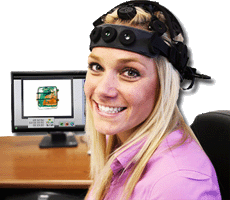 The
goal of this research project is to develop an improved
Transportation Security Officers (TSO) training system,
which will apply real-time brain-based measurements to provide
a customized training experience that is optimally suited
to the specific trainee. Specifically, this project is investigating
the combination of Electroencephalography (EEG) and eye-tracking
metrics for improving performance assessment on X-ray interpretation
tasks. The effects of training on performance is being explored
by comparing novice and expert screeners
The
goal of this research project is to develop an improved
Transportation Security Officers (TSO) training system,
which will apply real-time brain-based measurements to provide
a customized training experience that is optimally suited
to the specific trainee. Specifically, this project is investigating
the combination of Electroencephalography (EEG) and eye-tracking
metrics for improving performance assessment on X-ray interpretation
tasks. The effects of training on performance is being explored
by comparing novice and expert screeners -
Hybrid EEG Sensor Array for Brain/Computer Interfaces
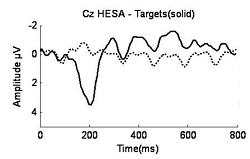 Independent
BCI use requires easily acquired, good-quality electroencephalographic
(EEG) signals maintained over long periods in less-than-ideal
electrical environments. Conventional, wet-sensor, electrodes
require careful application. Faulty or inadequate preparation,
noisy environments, or gel evaporation can result in poor
signal quality. Poor signal quality produces poor user performance,
system downtime, and user and caregiver frustration. This
study demonstrates that a hybrid dry electrode sensor array
(HESA) performs as well as traditional wet electrodes and
may help propel BCI technology to a widely accepted alternative
mode of communication.
Independent
BCI use requires easily acquired, good-quality electroencephalographic
(EEG) signals maintained over long periods in less-than-ideal
electrical environments. Conventional, wet-sensor, electrodes
require careful application. Faulty or inadequate preparation,
noisy environments, or gel evaporation can result in poor
signal quality. Poor signal quality produces poor user performance,
system downtime, and user and caregiver frustration. This
study demonstrates that a hybrid dry electrode sensor array
(HESA) performs as well as traditional wet electrodes and
may help propel BCI technology to a widely accepted alternative
mode of communication. -
A Closed-Loop Neuroergonomic System for Adaptive Training
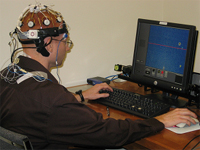 The
objective of this project is to demonstrate the feasibility
of developing an integrated system that monitors and provides
feedback on cognitive states to enhance and expedite warfighter
training. The system collects, cleans, and processes neurophysiologic,
physiological, and performance-based data in real-time from
individuals and teams during training in a currently fielded
simulation-based training environments.
The
objective of this project is to demonstrate the feasibility
of developing an integrated system that monitors and provides
feedback on cognitive states to enhance and expedite warfighter
training. The system collects, cleans, and processes neurophysiologic,
physiological, and performance-based data in real-time from
individuals and teams during training in a currently fielded
simulation-based training environments. -
Integrated Adaptive Aiding System for UAV Control and Related Applications
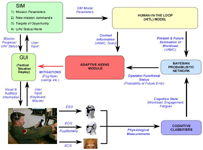 The
main goal of this Phase II program is to develop a Closed-Loop
Adaptive Aiding System (CLAAS) that improves UAV mission
performance by adaptively reducing operator cognitive workload.
We utilize QUASAR’s breakthrough wearable dry-electrode
based physiological monitoring system to classify two operators’
cognitive states during a multi-UAV simulation task. Each
operator’s cognitive states are combined with present and
future mission context to predict the probability of failure
(POF) due to operator error. To close the loop in this project,
a supervisor is presented mission information along with
each operator’s POF, and is then able to shift tasks from
one operator to the other in order to reduce operator cognitive
workload and hence enhance team mission performance.
The
main goal of this Phase II program is to develop a Closed-Loop
Adaptive Aiding System (CLAAS) that improves UAV mission
performance by adaptively reducing operator cognitive workload.
We utilize QUASAR’s breakthrough wearable dry-electrode
based physiological monitoring system to classify two operators’
cognitive states during a multi-UAV simulation task. Each
operator’s cognitive states are combined with present and
future mission context to predict the probability of failure
(POF) due to operator error. To close the loop in this project,
a supervisor is presented mission information along with
each operator’s POF, and is then able to shift tasks from
one operator to the other in order to reduce operator cognitive
workload and hence enhance team mission performance. -
Real-Time Bio-Sensors for Enhanced C2ISR Operator Performance
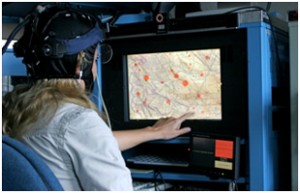 QUASAR
has built an EEG headset for use in Command and Control,
Intelligence, Surveillance, and Reconnaissance (C2ISR) missions,
and developed software to classify workload and engagement.
This system combines physiological real-time measurements
with simulation context information to predict operator’s
future Probability of Failure (POF).
QUASAR
has built an EEG headset for use in Command and Control,
Intelligence, Surveillance, and Reconnaissance (C2ISR) missions,
and developed software to classify workload and engagement.
This system combines physiological real-time measurements
with simulation context information to predict operator’s
future Probability of Failure (POF). -
Wearable Electrophysiologic Sensor Suite for Detection of Neurotoxic Effects
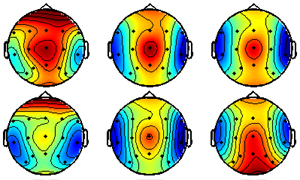 The
goal of this STTR program was to develop and validate a
gauge for impending cognitive dysfunction, especially that
induced by neurotoxins, using only wearable sensors. A gauge
is a set of algorithms that combines information from a
number of indicators of brain and central nervous system
activity to give a simple, one-dimensional alarm output.
The term “wearable sensors” means that the component of
the device that collects the signal does not have to be
in intimate contact with the skin, and is small and lightweight.
The
goal of this STTR program was to develop and validate a
gauge for impending cognitive dysfunction, especially that
induced by neurotoxins, using only wearable sensors. A gauge
is a set of algorithms that combines information from a
number of indicators of brain and central nervous system
activity to give a simple, one-dimensional alarm output.
The term “wearable sensors” means that the component of
the device that collects the signal does not have to be
in intimate contact with the skin, and is small and lightweight.
